Free Vibrations and Flutter Analysis of Composite Plates Reinforced with Carbon Nanotubes
Abstract
1. Introduction
2. Materials and Methods
2.1. Micromechanical Modeling
2.2. Constitutive Equations
2.3. Equations of Motion
- Simply supported: w = w” = 0 on x = 0 and x = a;
- Clamped supported: w = w’ = 0 on x = 0 and x = a.
- For a simply supported plate (SSSS)
- For a clamped plate (SCSC)
3. Results and Discussion
3.1. Modeling Verification
3.2. Free Vibration Analysis of CNT/Nanocomposite Plates
3.3. Flutter Analysis of CNT/Nanocomposite Plates
4. Conclusions
- For all nanotube volume fractions analyzed, increasing the aspect ratio decreases the fundamental frequency. When the volume fraction of CNTs was increased from 1% to 5%, a 2.7-fold improvement in frequency was observed. The effect of the volume fraction of CNTs on frequencies decreases with increasing aspect ratios.
- A lower frequency was observed with thinner nanocomposite sheets. However, the differences decrease as the aspect ratio of the plate increases. The growth in thickness at a constant width-to-length ratio influenced the increase in natural frequencies, and it was a constant increase of 2.5-fold.
- It was shown that even low-volume fractions of nanotubes can effectively increase the natural frequencies of nanocomposite plates.
- It was shown that the higher the volume fraction of CNTs, the narrower the eigenvalue curves. However, the discrepancies are less pronounced for higher CNT volume fractions than isotropic cases.
- It can be seen that the boundary conditions affect the eigenvalue curve more than the CNT volume fraction.
- The possible solution to the flutter problem was mainly influenced by the changes in the eigenvalue curves. The coincidence or small differences in the position of the coalescence point for higher volume fractions of CNTs were caused by the shape of the eigenvalue curves. For the higher volume fraction of CNTs, there was almost the same shape and position of the eigenvalue curve.
Funding
Institutional Review Board Statement
Informed Consent Statement
Data Availability Statement
Conflicts of Interest
References
- Ali, Z.; Yaqoob, S.; Yu, J.; D’Amore, A. Critical review on the characterization, preparation, and enhanced mechanical, thermal, and electrical properties of carbon nanotubes and their hybrid filler polymer composites for various applications. Compos. C 2024, 13, 100434. [Google Scholar] [CrossRef]
- Liu, Q.; Fan, G.; Tan, Z.; Saba, F.; Guo, Q.; Xiong, D.; Su, Y.; Li, Z.; Zhang, D. Effect of thermomechanical treatment and length-scales on spatial distribution of CNTs in Al matrix. Carbon 2022, 190, 384–394. [Google Scholar] [CrossRef]
- Li, W.; Feng, Z.; Weiguang, S.; Xingyuan, X.; Anqing, L.; Yunlun, L.; Chonghai, X.; Yu, S. Green Manufacturing of Flexible Sensors with a Giant Gauge Factor: Bridging Effect of CNT and Electric Field Enhancement at the Percolation Threshold. ACS Appl. Mater. Interfaces 2022, 14, 26024–26033. [Google Scholar]
- Yang, H.; Yuan, L.; Yao, X.F.; Zheng, Z.; Fang, D.N. Monotonic strain sensing behavior of self-assembled carbon nanotubes/graphene silicone rubber composites under cyclic loading. Compos. Sci. Technol. 2020, 200, 108474. [Google Scholar] [CrossRef]
- Chai, Y.; Gao, W.; Ankay, B.; Li, F.; Zhang, C. Aeroelastic analysis and flutter control of wings and panels: A review. Int. J. Mech. Syst. Dyn. 2021, 1, 5–34. [Google Scholar] [CrossRef]
- Liew, K.M.; Lei, Z.X.; Zhang, L.W. Mechanical analysis of functionally graded carbon nanotube reinforced composites: A review. Compos. Struct. 2015, 120, 90–97. [Google Scholar] [CrossRef]
- Asadi, H.; Souri, M.; Wang, Q. A numerical study on flow-induced instabilities of supersonic FG-CNT reinforced composite flat panels in thermal environments. Compos. Struct. 2017, 171, 113–125. [Google Scholar] [CrossRef]
- Arena, A.; Talóa, M.; Snyder, M.P.; Lacarbonara, W. Enhancing flutter stability in nanocomposite thin panels by harnessing CNT/polymer dissipation. Mech. Res. Commun. 2020, 104, 103495. [Google Scholar] [CrossRef]
- Chwał, M.; Muc, A. Design of reinforcement in nano and microcomposites. Materials 2019, 12, 1474. [Google Scholar] [CrossRef]
- Lin, R.M.; Lu, C. Modeling of interfacial friction damping of carbon nanotube-based nanocomposites. Mech. Syst. Signal Process. 2010, 24, 2996–3012. [Google Scholar] [CrossRef]
- Garcia, E.J.; Hart, A.J.; Wardle, B.L.; Slocum, A.H. Fabrication and nanocompression testing of aligned carbon-nanotube–polymer nanocomposites. Adv. Mater. 2007, 19, 2151–2156. [Google Scholar] [CrossRef]
- Fidelus, J.D.; Wiesel, E.; Gojny, F.H.; Schulte, K.; Wagner, H.D. Thermo-mechanical properties of randomly oriented carbon/epoxy nanocomposites. Compos. Part A 2005, 36, 1555–1561. [Google Scholar] [CrossRef]
- Shen, S.H. Nonlinear bending of functionally graded carbon nanotube-reinforced composite plates in thermal environments. Compos. Struct. 2009, 91, 9–19. [Google Scholar] [CrossRef]
- Shen, H.S.; Xiang, Y. Thermal postbuckling of nanotube-reinforced composite cylindrical panels resting on elastic foundations. Compos. Struct. 2015, 123, 383–392. [Google Scholar] [CrossRef]
- Jonsson, E.; Riso, C.; Lupp, C.A.; Cesnik, C.E.S.; Martins, J.R.R.A.; Epureanu, B.I. Flutter and post-flutter constraints in aircraft design optimization. Prog. Aerosp. Sci. 2019, 109, 100537. [Google Scholar] [CrossRef]
- Muc, A.; Flis, J.; Augustyn, M. Optimal design of plated/shell structures under flutter constraints—A literature review. Materials 2019, 12, 4215. [Google Scholar] [CrossRef]
- Kameyama, M.; Fukunaga, H. Optimum design of composite plate wings for aeroelastic characteristics using lamination parameters. Comput. Struct. 2007, 85, 213–224. [Google Scholar] [CrossRef]
- Formica, G.; Talo, M.; Lacarbonara, W. Nonlinear modeling of carbon nanotube composites dissipation due to interfacial stick–slip. Int. J. Plast. 2014, 53, 148–163. [Google Scholar] [CrossRef]
- Wang, M.; Li, Z.M.; Qiao, P. Semi-analytical solutions to buckling and free vibration analysis of carbon nanotube-reinforced composite thin plates. Compos. Struct. 2016, 144, 33–43. [Google Scholar] [CrossRef]
- Guo, H.; Li, M.; Żur, K.K.; Yuan, J.; Wu, X. Flutter of carbon-based nanohybrid composite panels. Thin-Walled Struct. 2023, 188, 110828. [Google Scholar] [CrossRef]
- Liu, C.; Xie, C.; Meng, Y.; Bai, L. Experimental and Numerical Flutter Analysis Using Local Piston Theory with Viscous Correction. Aerospace 2023, 10, 870. [Google Scholar] [CrossRef]
- Huang, K.; Guo, H.; Qin, Z.; Cao, S.; Chen, Y. Flutter analysis of laminated composite quadrilateral plates reinforced with graphene nanoplatelets using the element-free IMLS-Ritz method. Aerosp. Sci. Technol. 2020, 103, 105915. [Google Scholar] [CrossRef]
- Camacho, P.; Akhavan, H.; Ribeiro, P. Linear aeroelastic analysis of cantilever hybrid composite laminated plates with curvilinear fibres and carbon nanotubes. Compos. Struct. 2021, 266, 113765. [Google Scholar] [CrossRef]
- Maraghi, Z.K. Flutter and divergence instability of nanocomposite sandwich plate with magnetostrictive face sheets. J. Sound. Vib. 2019, 457, 240–260. [Google Scholar] [CrossRef]
- Khan, S.U.; Pothnis, J.R.; Kim, J.-K. Effects of carbon nanotube alignment on electrical and mechanical properties of epoxy nanocomposites. Compos. Part. A Appl. Sci. Manuf. 2013, 49, 26–34. [Google Scholar] [CrossRef]
- Liu, L.; Han, J.; Xu, L.; Zhou, J.; Zhao, C.; Ding, S.; Shi, H.; Xiao, M.; Ding, L.; Ma, Z.; et al. Aligned, high-density semiconducting carbon nanotube arrays for high-performance electronics. Science 2020, 368, 850–856. [Google Scholar] [CrossRef]
- Guan, L.-Z.; Tang, L.-C. Dispersion and Alignment of Carbon Nanotubes in Polymer Matrix. In Handbook of Carbon Nanotubes; Springer: Berlin/Heidelberg, Germany, 2021; pp. 1–35. [Google Scholar]
- Yin, Z.; Ding, A.; Zhang, H.; Zhang, W. The Relevant Approaches for Aligning Carbon Nanotubes. Micromachines 2022, 13, 1863. [Google Scholar] [CrossRef]
- Talapatra, A.; Datta, D. A review of the mechanical, thermal and tribological properties of graphene reinforced polymer nanocomposites: A molecular dynamics simulations methods. Polym. Bull. 2023, 80, 2299–2328. [Google Scholar] [CrossRef]
- Hou, G.; Ren, R.; Shang, W.; Weng, Y.; Liu, J. Molecular dynamics simulation of polymer nanocomposites with supramolecular network constructed via functionalized polymer end-grafted nanoparticles. Polymers 2023, 15, 3259. [Google Scholar] [CrossRef]
- Muc, A.; Barski, M. Design of particulate-reinforced composite materials. Materials 2018, 11, 234. [Google Scholar] [CrossRef]
- Chwał, M.; Muc, A. Buckling and free vibrations of nanoplates—Comparison of nonlocal strain and stress approaches. Appl. Sci. 2019, 9, 1409. [Google Scholar] [CrossRef]
- Huang, Y.-J.; Natarajan, S.; Zhang, H.; Guo, F.-Q.; Xu, S.-L.; Chen, Z.; Zheng, Z.-S. CT image-driven computational framework for investigating complex 3D fracture in mesoscale concrete. Cem. Concr. Compos. 2023, 143, 105270. [Google Scholar] [CrossRef]
- Kimiyoshi, N.; Chiemi, N.; Keiichi, S.; Yoshinobu, S.; Yoku, I. Tensile properties and fracture behavior of carbon nanotube-sheets/carbon fibers epoxy-impregnated bundle composites. Polym. Polym. Compos. 2022, 30, 1–11. [Google Scholar]
- Pei, N.; Shang, J.; Bond, L.J. Analysis of Progressive Tensile Damage of Multi-walled Carbon Nanotube Reinforced Carbon Fiber Composites by Using Acoustic Emission and Micro-CT. J. Nondestruct. Eval. 2021, 40, 51. [Google Scholar] [CrossRef]
- Chwał, M. Nonlocal analysis of natural vibrations of carbon nanotubes. J. Mater. Eng. Perform. 2018, 27, 6087–6096. [Google Scholar] [CrossRef]
- Lei, Z.X.; Liew, K.M.; Yu, J.L. Free vibration analysis of functionally graded carbon nanotube-reinforced composite plates using the element-free kp-Ritz method in thermal environment. Compos. Struct. 2013, 106, 128–138. [Google Scholar] [CrossRef]
- Wang, Z.X.; Shen, H.S. Nonlinear dynamic response of nanotube-reinforced composite plates resting on elastic foundations in thermal environments. Nonlinear Dyn. 2012, 70, 735–754. [Google Scholar] [CrossRef]
- Shokrieh, M.M.; Rafiee, R. Prediction of Young’s Modulus of Graphene Sheets and Carbon Nanotubes Using Nanoscale Continuum Mechanics Approach. Mater. Des. 2010, 31, 790–795. [Google Scholar] [CrossRef]
- Paris, O. (Ed.) Structure and Multiscale Mechanics of Carbon Nanomaterials; Springer: Berlin/Heidelberg, Germany, 2016. [Google Scholar]
- Vanin, G.A. Micro-Mechanics of Composite Materials; Nauka Dumka: Kiev, Ukraine, 1985. [Google Scholar]
- Fazelzadeh, S.A.; Pouresmaeeli, S.; Ghavanloo, E. Aeroelastic characteristics of functionally graded carbon nanotube-reinforced composite plates under a supersonic flow. Comput. Methods Appl. Mech. Eng. 2015, 285, 714–729. [Google Scholar] [CrossRef]
- Hussein, O.S.; Mulani, S.B. Nonlinear aeroelastic stability analysis of in-plane functionally graded metal nanocomposite thin panels in supersonic flow. Thin-Walled Struct. 2019, 139, 398–411. [Google Scholar] [CrossRef]
- Kouchakzadeh, M.A.; Rasekh, M.; Haddadpour, H. Panel flutter analysis of general laminated composite plates. Compos. Struct. 2010, 92, 2906–2915. [Google Scholar] [CrossRef]
- Li, J.; Narita, Y. Analysis and optimal design for supersonic composite laminated plate. Compos. Struct. 2013, 101, 35–46. [Google Scholar] [CrossRef]
- Muc, A.; Flis, J. Closed form solutions—Analysis and optimal design of supersonic composite laminated flat plates considering mechanical and thermal effects. Compos. Struct. 2019, 230, 111491. [Google Scholar] [CrossRef]
- Bakhtiari, M.; Lakis, A.A.; Kerboua, Y. Nonlinear supersonic flutter of truncated conical shells. J. Mech. Sci. Technol. 2020, 34, 1375–1388. [Google Scholar] [CrossRef]
- Zhang, L.W.; Song, Z.G.; Liew, K.M. Computation of aerothermoelastic properties and active flutter control of CNT reinforced functionally graded composite panels in supersonic airflow. Comput. Methods Appl. Mech. Eng. 2016, 300, 427–441. [Google Scholar] [CrossRef]
- Avramov, K.V.; Chernobryvko, M.; Uspensky, B.; Seitkazenova, K.K.; Myrzaliyev, D. Self-sustained vibrations of functionally graded carbon nanotubes-reinforced composite cylindrical shells in supersonic flow. Nonlinear Dyn. 2019, 98, 1853–1876. [Google Scholar] [CrossRef]
- Muc, A. Transverse shear effects in supersonic flutter problems for composite multilayered rectangular plates—Benchmark for numerical analysis. Compos. Part C 2020, 1, 100001. [Google Scholar] [CrossRef]
- Reddy, J.N. Mechanics of Laminated Composite Plates and Shells; CRC Press: Boca Raton, FL, USA, 2003. [Google Scholar]
- Meijer, M.C.; Dala, L. A generalized formulation and review of piston theory for airfoils. AIAA J. 2016, 54, 17–27. [Google Scholar] [CrossRef]
- Arani, A.G.; Soleymani, T. Size-dependent vibration analysis of a rotating MR sandwich beam with varying cross section in supersonic airflow. Int. J. Mech. Sci. 2019, 151, 288–299. [Google Scholar] [CrossRef]
- Chen, J.; Han, R.; Liu, D.; Zhang, W. Active flutter suppression and aeroelastic response of functionally graded multilayer graphene nanoplatelet reinforced plates with piezoelectric patch. Appl. Sci. 2022, 12, 1244. [Google Scholar] [CrossRef]
- Prakash, T.; Ganapathi, M. Supersonic flutter characteristics of functionally graded flat panels including thermal effects. Compos. Struct. 2006, 72, 10–18. [Google Scholar] [CrossRef]
- Bolotin, V.V. Nonconservative Problems of the Theory of Elastic Stability; Pergamon Press: Oxford, UK, 1963. [Google Scholar]
- Lin, K.J.; Lu, P.J.; Tarn, J.Q. Flutter analysis of composite panels using high precision finite elements. Comput. Struct. 1989, 33, 561–574. [Google Scholar]
- Guo, H.; Żur, K.K.; Ouyang, X. New insights into the nonlinear stability of nanocomposite cylindrical panels under aero-thermal loads. Compos. Struct. 2023, 303, 116231. [Google Scholar] [CrossRef]

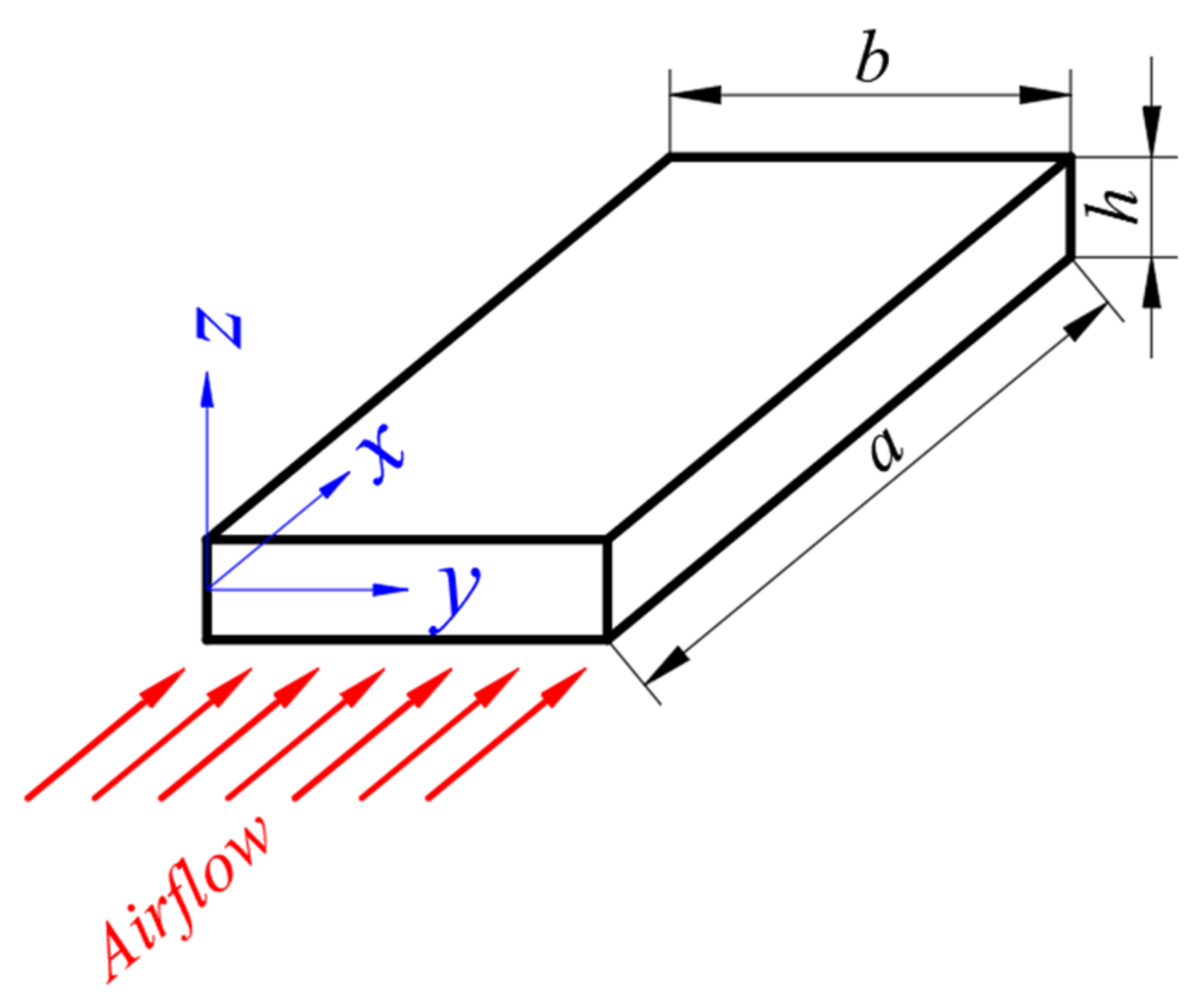
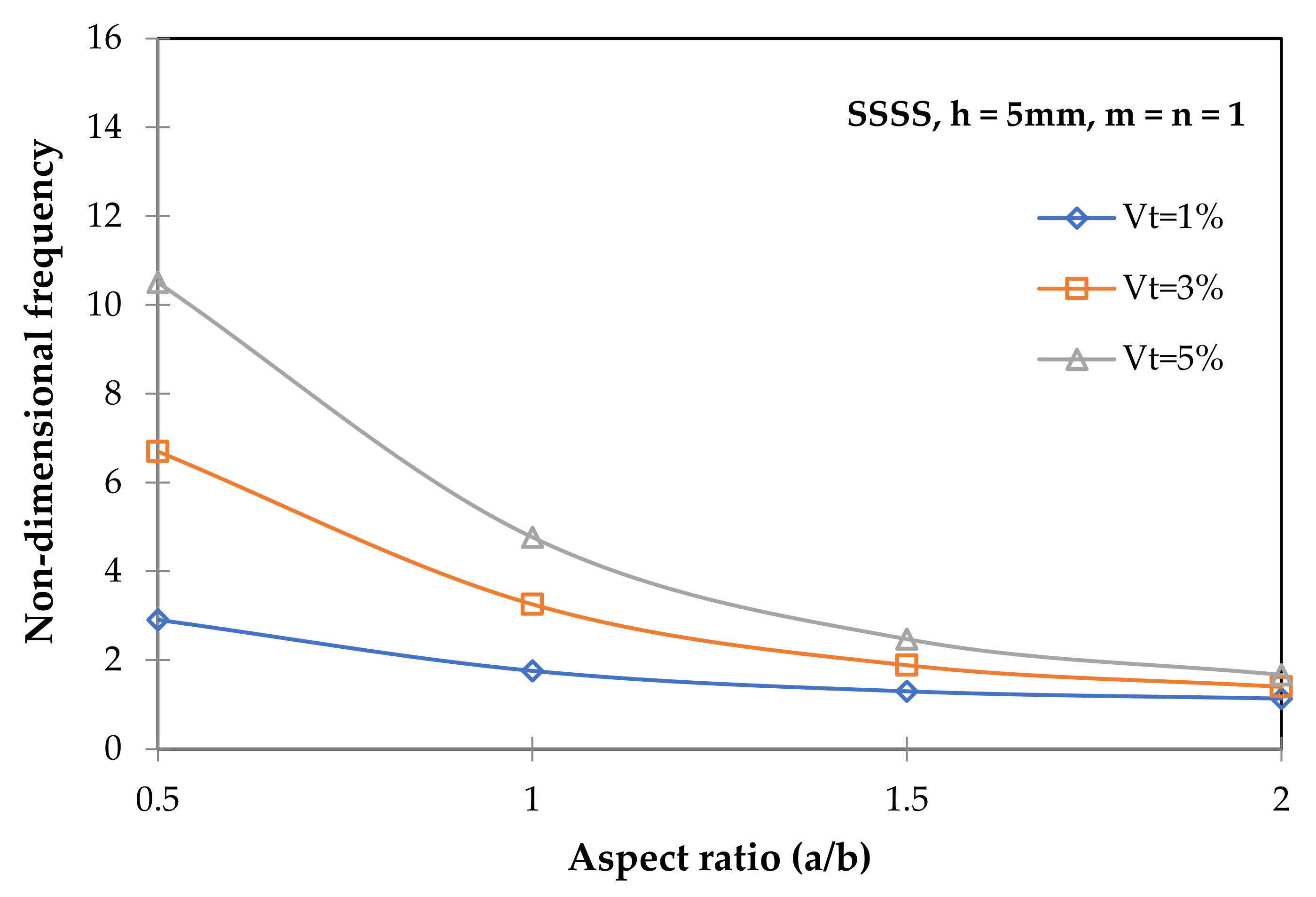
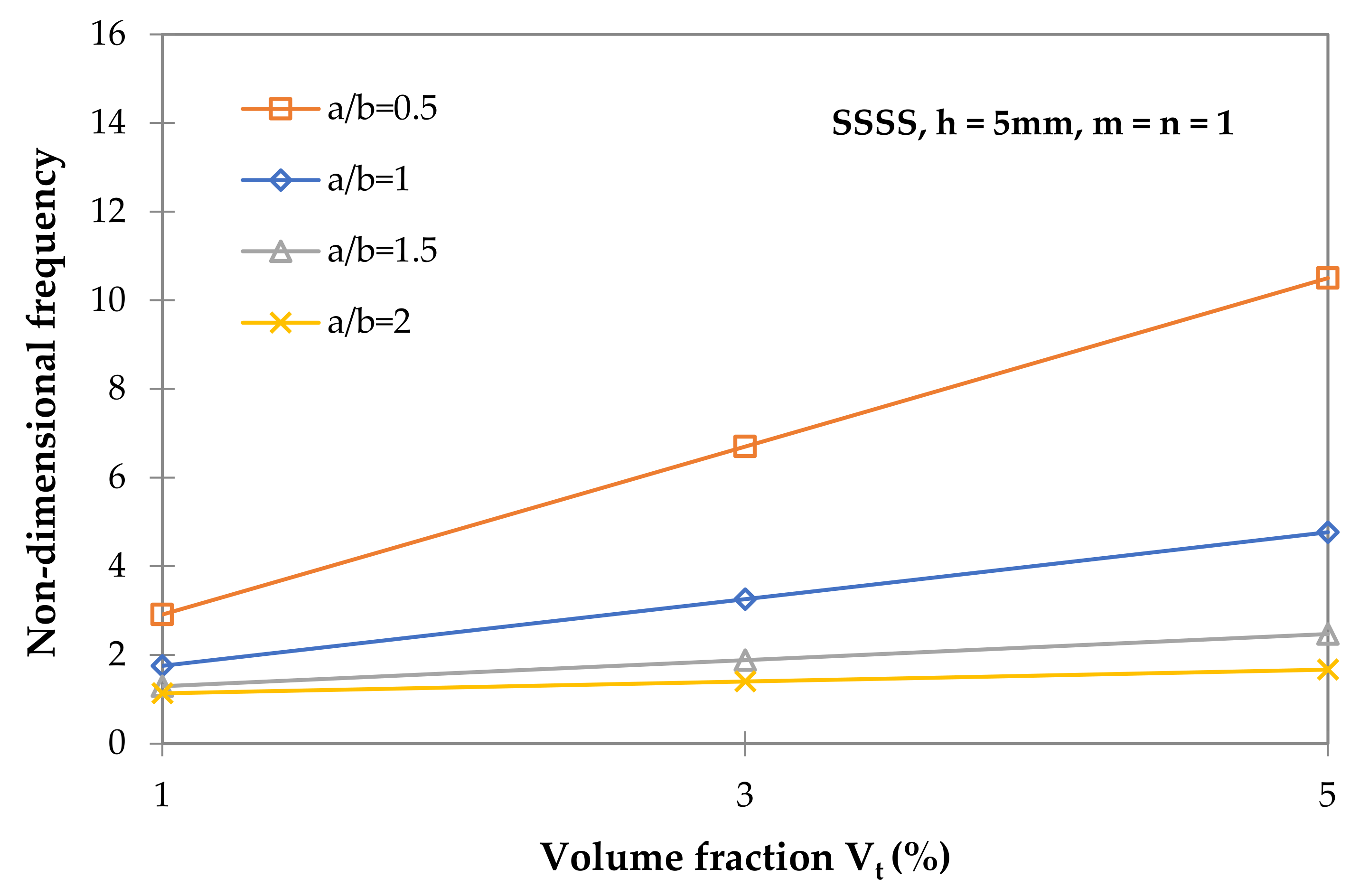


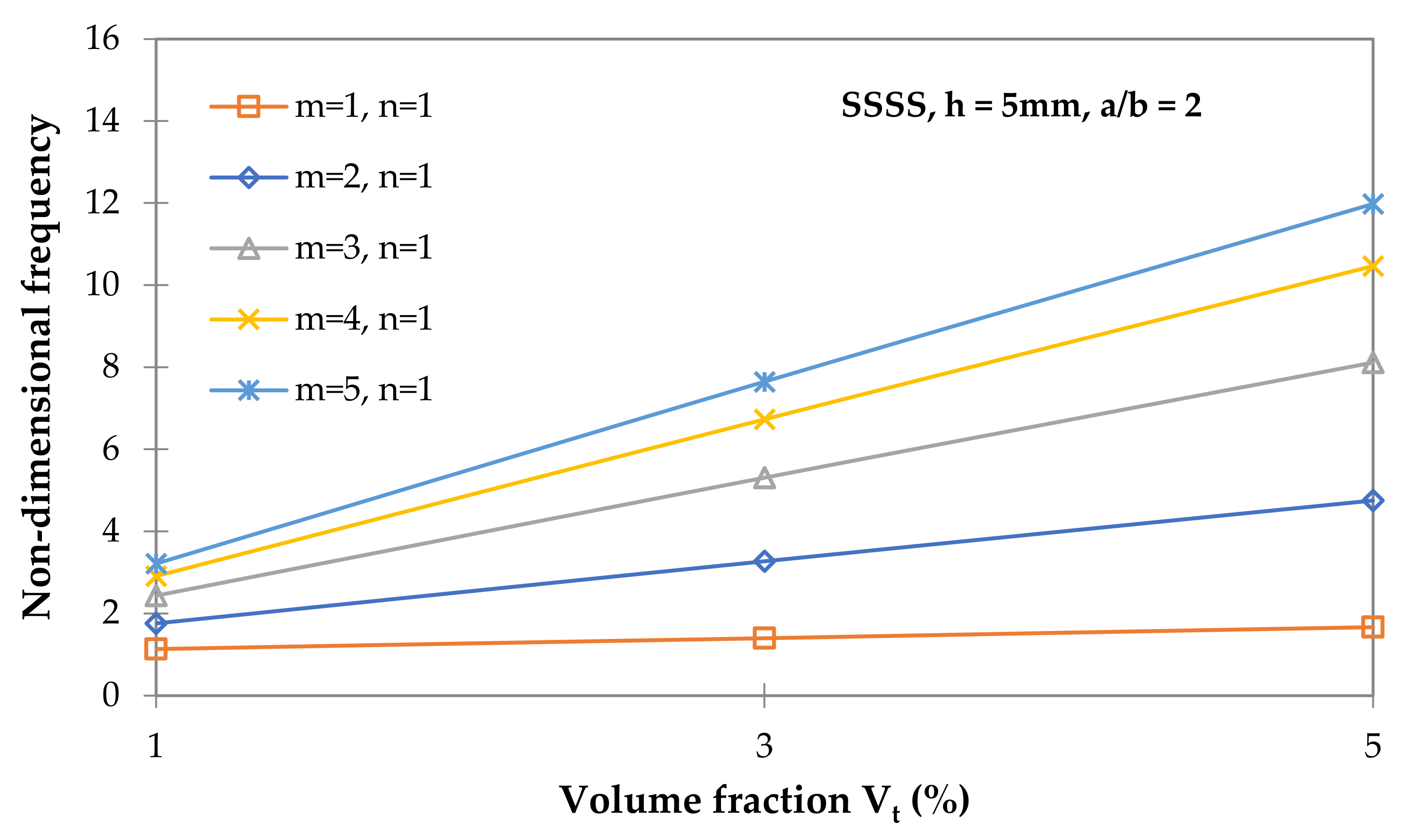

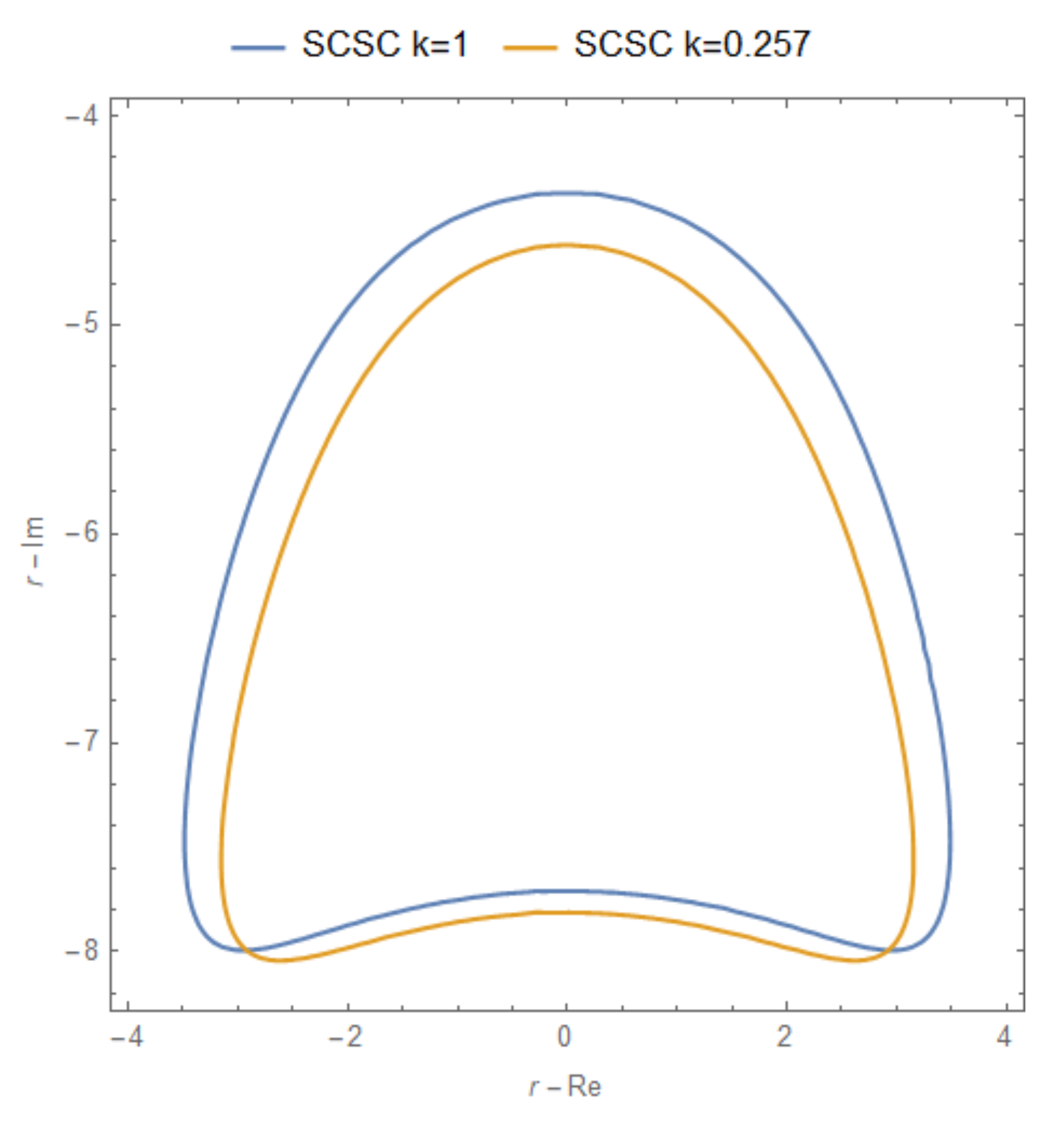
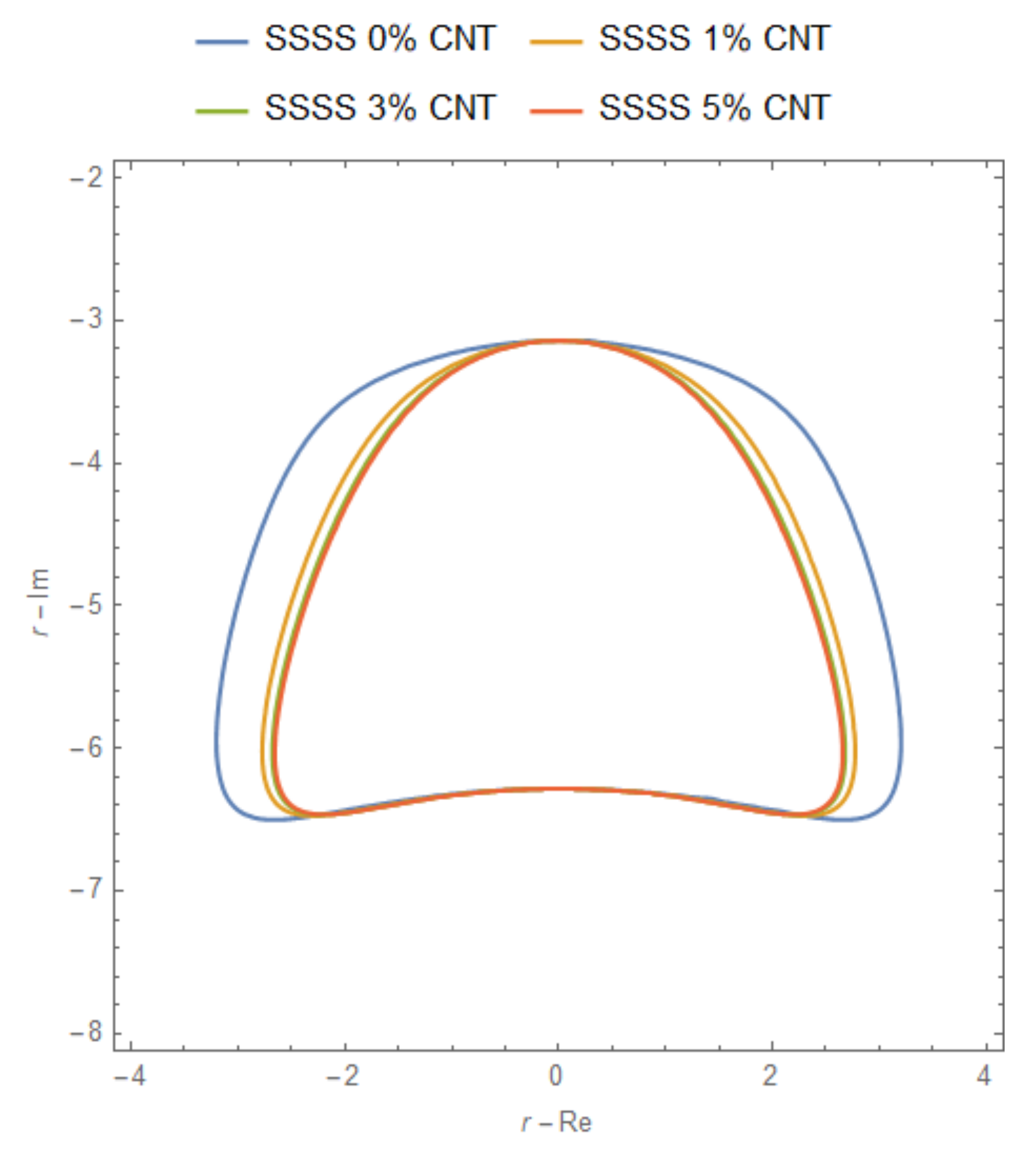
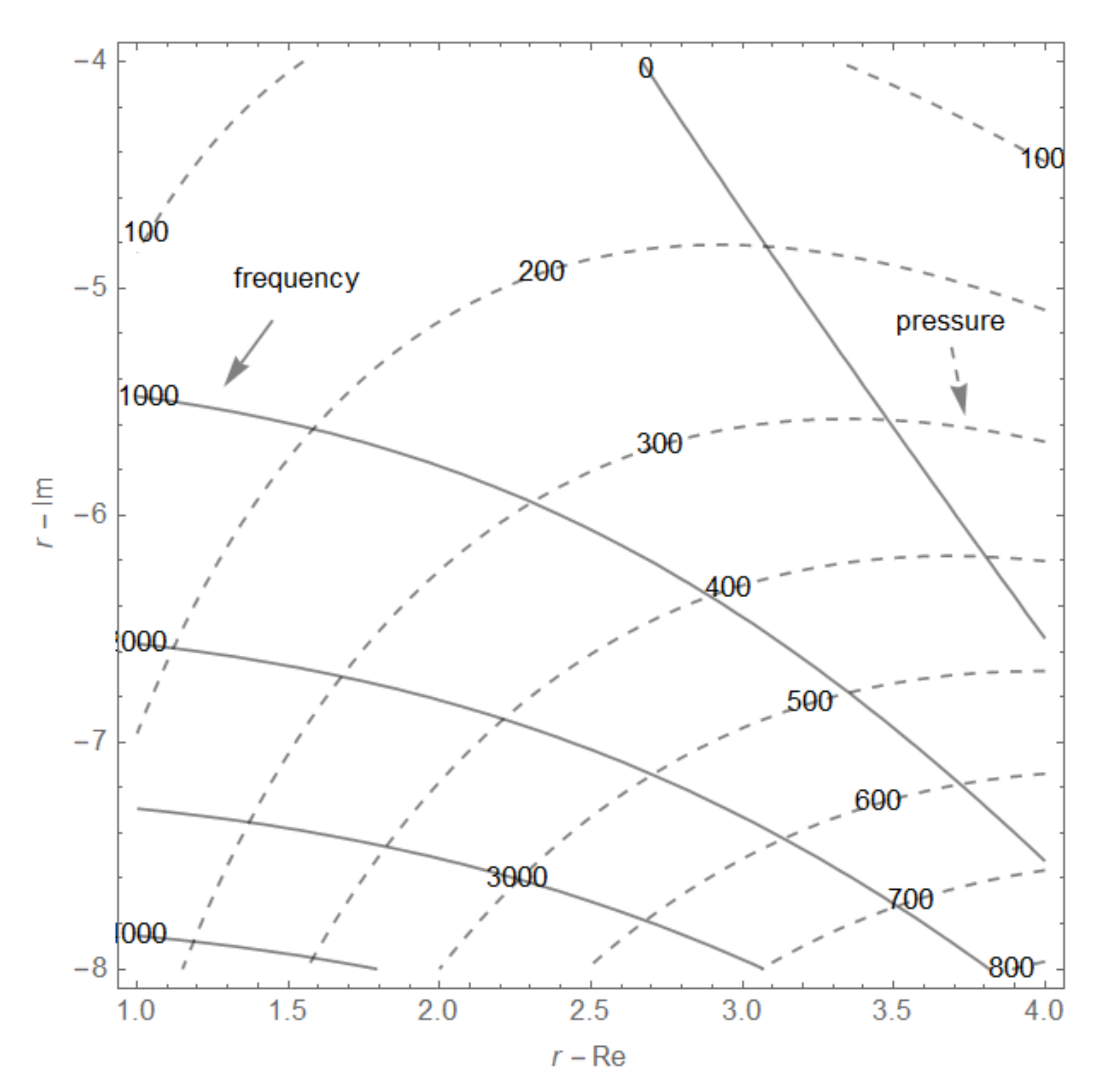

| Material | Young’s Modulus (GPa) | Poisson’s Ratio | Density (kg/m3) |
|---|---|---|---|
| Carbon nanotubes | 1000 | 0.175 | 1400 |
| Epoxy matrix | 2.945 | 0.35 | 1200 |
| Material Constant | CNT’s Volume Fraction | ||
|---|---|---|---|
| 1% | 3% | 5% | |
| E11 (GPa) | 12.917 | 32.86 | 52.804 |
| E22 (GPa) | 3.3 | 3.469 | 3.596 |
| G12 (GPa) | 1.113 | 1.158 | 1.205 |
| G23 (GPa) | 1.109 | 1.145 | 1.184 |
| ν21 | 0.352 | 0.357 | 0.361 |
| ν23 | 0.489 | 0.514 | 0.519 |
| Density (kg/m3) | 1202 | 1206 | 1210 |
| The Volume Fraction of CNTs | Simply Supported Square Plate | ||
|---|---|---|---|
| Non-Dimensional Critical Pressure β | Non-Dimensional Coalescent Frequency λ | Parameter k | |
| Vt = 1% | 385 | 1200 | 0.257 |
| Vt = 3% | 360 | 1100 | 0.107 |
| Vt = 5% | 354 | 1100 | 0.069 |
Disclaimer/Publisher’s Note: The statements, opinions and data contained in all publications are solely those of the individual author(s) and contributor(s) and not of MDPI and/or the editor(s). MDPI and/or the editor(s) disclaim responsibility for any injury to people or property resulting from any ideas, methods, instructions or products referred to in the content. |
© 2025 by the author. Licensee MDPI, Basel, Switzerland. This article is an open access article distributed under the terms and conditions of the Creative Commons Attribution (CC BY) license (https://creativecommons.org/licenses/by/4.0/).
Share and Cite
Chwał, M. Free Vibrations and Flutter Analysis of Composite Plates Reinforced with Carbon Nanotubes. Appl. Sci. 2025, 15, 1140. https://doi.org/10.3390/app15031140
Chwał M. Free Vibrations and Flutter Analysis of Composite Plates Reinforced with Carbon Nanotubes. Applied Sciences. 2025; 15(3):1140. https://doi.org/10.3390/app15031140
Chicago/Turabian StyleChwał, Małgorzata. 2025. "Free Vibrations and Flutter Analysis of Composite Plates Reinforced with Carbon Nanotubes" Applied Sciences 15, no. 3: 1140. https://doi.org/10.3390/app15031140
APA StyleChwał, M. (2025). Free Vibrations and Flutter Analysis of Composite Plates Reinforced with Carbon Nanotubes. Applied Sciences, 15(3), 1140. https://doi.org/10.3390/app15031140






